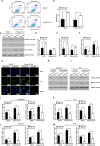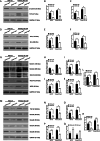Identification of gastric cancer stem cells with CD44 and Lgr5 double labelling and their initial roles on gastric cancer malignancy and chemotherapy resistance
- PMID: 39707072
- PMCID: PMC11662044
- DOI: 10.1007/s10565-024-09960-8
Identification of gastric cancer stem cells with CD44 and Lgr5 double labelling and their initial roles on gastric cancer malignancy and chemotherapy resistance
Abstract
Accumulating evidences have indicated that cancer stem cells (CSCs) can initiate tumor progression and cause recurrence after therapy. However, specific markers of gastric CSCs (GCSCs) from different origins have not been comprehensively revealed. Here, we further detected whether cell populations labelled with CD44 and Lgr5, well-recognized stem markers for gastric cancer (GC), can better emphasize cancer initiation, therapeutic resistance and recurrence. Flow cytometry was utilized to sort the CD44 + Lgr5 + and CD44 + Lgr5- cells from GC cell line HGC-27 and primary GC cells. The influences of CD44 and Lgr5 GCSCs on the malignant behaviors and their potential mechanisms was investigated, respectively. In our study, we reported the identification and validation of CD44 + Lgr5 + cells that presented stronger stemness characteristics, as evidenced by increase of sphere forming ability, elevation of stem cell transcriptional activity. Additionally, CD44 + Lgr5 + double positive cells have lower apoptosis, greater chemotherapy resistance, and higher EMT capacity and LC3 density compared with CD44 + Lgr5- cells. Tumor xenograft experiments also verified the faster carcinogenesis of CD44 + Lgr5 + GCSCs. Furthermore, a series of key proteins in the Wnt, Hedgehog, Notch, and TGF-β pathways were elevated in the CD44 + Lgr5 + double positive subpopulation, except for Notch 1 and Smad 1. In conclusion, the binding of CD44 and Lgr5 can serve as a precise GCSCs marker that initiate malignant progression and chemotherapy resistance in GC by activating Wnt, Hedgehog, Notch, TGF-β pathways. Those evidences raise the needs to target both markers simultaneously as a potential approach for the GC treatment.
Keywords: CD44; Cancer stem cell; Chemotherapy resistance; Epithelial-mesenchymal transformation; Gastric cancer; Lgr5.
© 2024. The Author(s).
Conflict of interest statement
Declarations. Ethical approval: All animal experiments were approved by the Animal Ethics Committee of Beijing Viewsolid Biotechnology Co. LTD (VS2126A23528). Conflicts of interest: The authors declare no competing interests.
Figures





Similar articles
-
LGR5 Is a Gastric Cancer Stem Cell Marker Associated with Stemness and the EMT Signature Genes NANOG, NANOGP8, PRRX1, TWIST1, and BMI1.PLoS One. 2016 Dec 29;11(12):e0168904. doi: 10.1371/journal.pone.0168904. eCollection 2016. PLoS One. 2016. PMID: 28033430 Free PMC article.
-
Xiaotan Sanjie decoction attenuates tumor angiogenesis by manipulating Notch-1-regulated proliferation of gastric cancer stem-like cells.World J Gastroenterol. 2014 Sep 28;20(36):13105-18. doi: 10.3748/wjg.v20.i36.13105. World J Gastroenterol. 2014. PMID: 25278704 Free PMC article.
-
RETRACTED: CD44 expression denotes a subpopulation of gastric cancer cells in which Hedgehog signaling promotes chemotherapy resistance.Clin Cancer Res. 2014 Aug 1;20(15):3974-88. doi: 10.1158/1078-0432.CCR-14-0011. Epub 2014 Jun 19. Clin Cancer Res. 2014. Retraction in: Clin Cancer Res. 2024 Oct 15;30(20):4803. doi: 10.1158/1078-0432.CCR-24-2134. PMID: 24947926 Free PMC article. Retracted. Clinical Trial.
-
Gastric cancer stem cells in gastric carcinogenesis, progression, prevention and treatment.World J Gastroenterol. 2014 May 14;20(18):5420-6. doi: 10.3748/wjg.v20.i18.5420. World J Gastroenterol. 2014. PMID: 24833872 Free PMC article. Review.
-
Stem cells in gastric cancer.World J Gastroenterol. 2015 Jan 7;21(1):112-23. doi: 10.3748/wjg.v21.i1.112. World J Gastroenterol. 2015. PMID: 25574084 Free PMC article. Review.
Cited by
-
Cancer-Associated Fibroblasts: Heterogeneity, Cancer Pathogenesis, and Therapeutic Targets.MedComm (2020). 2025 Jul 11;6(7):e70292. doi: 10.1002/mco2.70292. eCollection 2025 Jul. MedComm (2020). 2025. PMID: 40656546 Free PMC article. Review.
-
Nanomaterials targeting cancer stem cells to overcome drug resistance and tumor recurrence.Front Oncol. 2025 Jun 6;15:1499283. doi: 10.3389/fonc.2025.1499283. eCollection 2025. Front Oncol. 2025. PMID: 40548119 Free PMC article. Review.
-
FBXO32 promotes gastric cancer progression by regulating NME1.Transl Cancer Res. 2025 Jun 30;14(6):3520-3531. doi: 10.21037/tcr-2024-2426. Epub 2025 Jun 27. Transl Cancer Res. 2025. PMID: 40687258 Free PMC article.
References
-
- Cao W, Li M, Liu J, Zhang S, Noordam L, Verstegen MMA, Wang L, Ma B, Li S, Wang W, Bolkestein M, Doukas M, Chen K, Ma Z, Bruno M, Sprengers D, Kwekkeboom J, van der Laan LJW, Smits R, Peppelenbosch MP, Pan Q. LGR5 marks targetable tumor-initiating cells in mouse liver cancer. Nat Commun. 2020;11:1961. - PMC - PubMed
Publication types
MeSH terms
Substances
Grants and funding
- Z181100006218011/Beijing Nova Program
- 20QNPY113/People's Liberation Army Medical Technology Top-notch Project
- 2020-JCJQ-ZQ-020/National Defense Science and Technology Outstanding Youth Science Foundation Program
- 22QNYC004/Independent scientific research project of People's Liberation Army high-level Scientific and Technological Innovative Talents Project
- 22QNCZ014/Youth Independent Innovation Science Fund Project of Chinese PLA General Hospital
LinkOut - more resources
Full Text Sources
Medical
Miscellaneous

